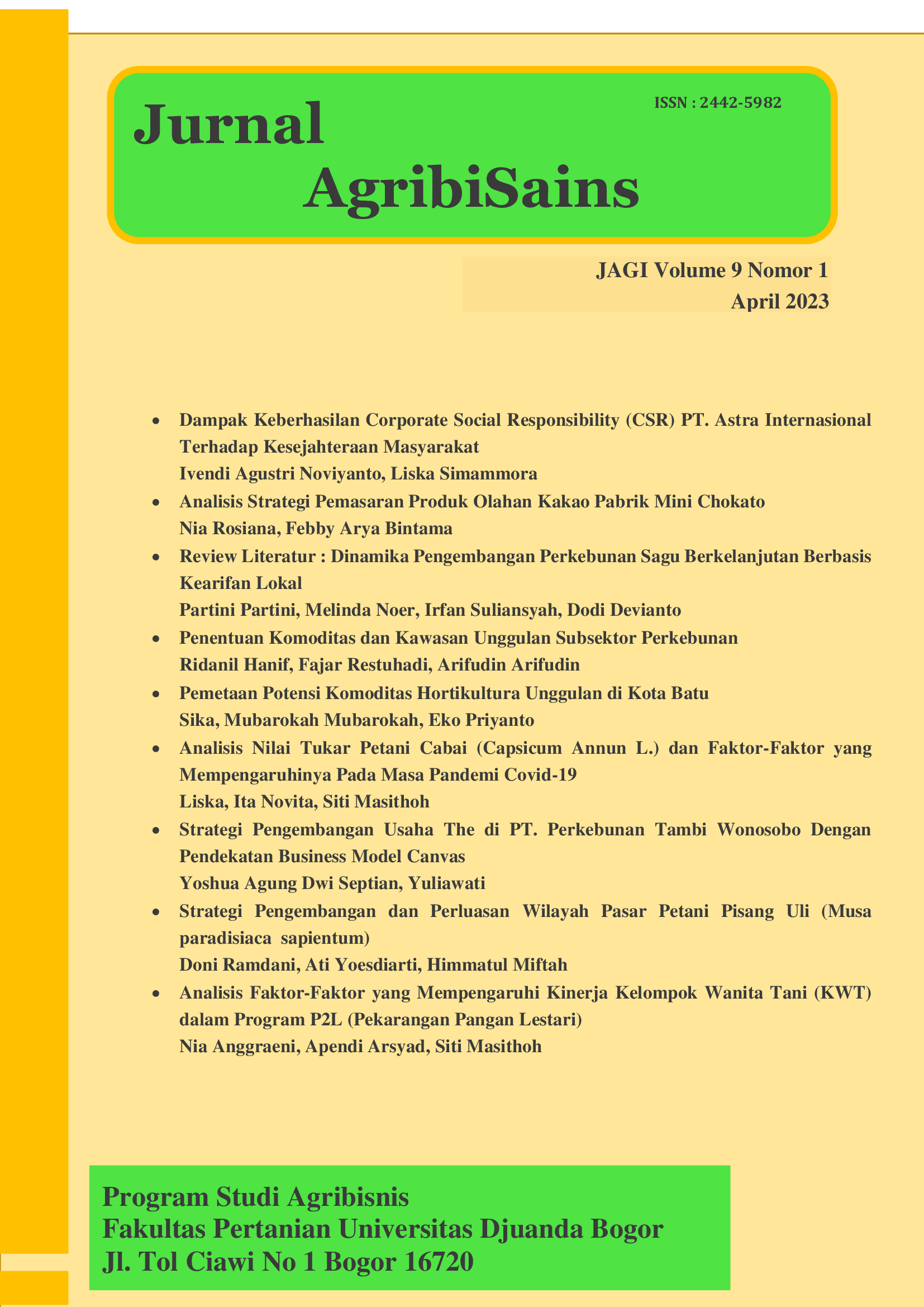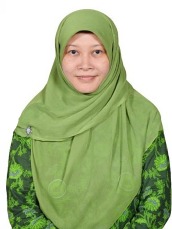PEMETAAN POTENSI KOMODITAS HORTIKULTURA UNGGULAN DI KOTA BATU
DOI:
https://doi.org/10.30997/jagi.v9i1.6627Keywords:
Agriculture, horticulture, location quotient (LQ), shift share analysis (SSA)Abstract
Horticulture is the agricultural subsector that is mostly occupied by farmers, this can be seen from the amount of land use for horticulture which is more dominant than other agricultural subsectors, according to the Department of Agriculture and food security, the horticulture sector has a planting area of 6449,758 hectares with a total area of 6449,758 hectares. As many as 71 horticultural commodities are cultivated, Batu City is one of the areas in East Java that relies on the agricultural sector for its economic development, but Batu City does not yet have a clear picture of the specifications for leading commodities, especially the horticulture sub-sector. The analytical tool that can be used to determine base and non-base commodities is Location Quotient (LQ) analysis, while the tool used to classify the growth of each commodity can use Shift Share Analysis (SSA), then the results of the two analyzes are combined with the Batu City geographic map using the technique Overlay so as to produce a map of Batu City's leading commodities. With the focus of research on every sub-district in Batu City, this is because the sub-district is an integral part of the city.
References
Amin, Z., Andry, A., & Humaidi, E. (2021). Pemetaan Sektor Agribisnis Pangan Unggulan di Kabupaten Musi Rawas. Jurnal Penelitian Pertanian Terapan, 21(1), 1–8. https://doi.org/10.25181/jppt.v21i1.1942
Bangun, R. H. (2017). Kajian Potensi Perkebunan Rakyat di Provinsi Sumatera Utara Menggunakan Location Quotient dan Shift Share. Jurnal Agrica. 10(1), 103–111.
Bangun, R. H. (2019). Potensi Subsektor Pertanian, Kehutanan dan Perikanan Unggulan Dalam Pembangunan Kabupaten Serdang Bedagai. Inovasi, 16(2), 75– 84. https://doi.org/10.33626/inovasi.v16i2.133
Bangun, R. H. (2020). Agroland : Jurnal Ilmu-Ilmu Pertanian Unggulan Untuk Mendukung Pembangunan Ekonomi. Agroland, 27(2), 118–129.
BPS. (2019). Total Luas Penggunaan Lahan Menurut Kecamatan di Kota Batu (Ha), 2019. Badan Pusat Statistik .https: // batukota. Bps .go .id / statictable /2020/05/14/729/ total- luas- penggunaan- lahan- menurut- kecamatan- di- kota-batu- ha- 2019.html
BPS. (2020a). (Seri 2010) PDRB Kota Batu Atas Dasar Harga Konstan 2010 Menurut Lapangan Usaha (Juta Rupiah), 2018-2020. Badan Pusat Statistik. https://batukota.bps.go.id/ indicator/52/71/1/-seri-2010-laju-pert umbuhan-pdrb-adhk-kota-batu menur ut-lapangan-usaha.html
Dinas Pertanian dan Ketahanan Pangan. (2020). Luas Panen Pertanian 2016-2020. Portal Data Kota Batu. https://portaldata.batukota.go.id/gl/dataset/luas-panen- pertanian-2020
Djadjuli, R. D. (2018). Peran Pemerintah Dalam Pembangunan Ekonomi Daerah. Jurnal Dinamika, 5(2), hal. 10.
Fahrizal, Sarfiah, S. N., & Juliprijanto, W. (2019). Analisis ketimpangan ekonomi provinsi Jawa Tengah tahun 2008-2017. DINAMIC: Directory Journal of Economic, 1(4), 399–417. http://jom.untidar.ac.id/index.php/dinamic/article/view/803/459
Heaton. 2004. Reworking Qualitative Data. London : Sage Publications Limited.
Novita, D., & Gultom, H. (2017). Strategi Pembangunan Ekonomi Wilayah Berbasis Sektor Unggulan di Kabupaten Langkat Provinsi Sumatera Utara. JASc (Journal of Agribusiness Sciences), 1(1), 1–7. https://doi.org/10.30596/jasc.v1i1.1540
Nursan, M., & Septiadi, D. (2020). Penentuan Prioritas Komoditas Unggulan Peternakan di Kabupaten Sumbawa Barat. Jurnal Ilmiah Agribisnis, 5(1), 29–34. https://doi.org/http: //dx.doi.org/10.37149/JIA.v5i1.9789
Pujiningtyas, D. H., & Nangameka, Y. (2018). Pemetaan Potensi Komoditas Unggulan Tanaman Pangan Di Kabupaten Situbondo. Ilmiah Agribisnis, 16(1), 43–54.
Sumarsono, H., Nasikh, & Muslikah, S. (2017). Indegenous Ekonomi Pembangunan Daerah. Gunung Samudera, Malang.
Syamsiyah, N., Sulistyodewi, & Karyani, T. (2017). Wilayah Potensial Dalam Pengembangan Agrowisata Buah Di Kabupaten Cirebon. Optima, 1(2), 1–9.
Wati, R. M., & Arifin, A. (2019). Analisis Location Quotient Dan Shift-Share Sub Sektor Pertanian di Kabupaten Pekalongan Tahun 2013-2017. Jurnal Ekonomi-Qu, 9(2), 200–213. https://doi.org/10.35448/jequ.v2i2.7167
Downloads
Published
How to Cite
Issue
Section
License
Copyright (c) 2023 JURNAL AGRIBISAINS

This work is licensed under a Creative Commons Attribution-ShareAlike 4.0 International License.
Authors who publish with Jurnal AgribiSains agree to the following terms:
- Authors retain copyright and grant the journal right of first publication with the work simultaneously licensed under a Creative Commons Attribution Share-Alike 4.0 International License that allows others to share the work with an acknowledgement of the work's authorship and initial publication in Jurnal AgribiSains.
- Authors are able to enter into separate, additional contractual arrangements for the non-exclusive distribution of the journal's published version of the work (e.g., post it to an institutional repository or publish it in a book), with an acknowledgement of its initial publication in Jurnal AgribiSains.
- Authors are permitted and encouraged to post their work online (e.g., in institutional repositories or on their website) prior to and during the submission process, as it can lead to productive exchanges, as well as earlier and greater citation of published work.









